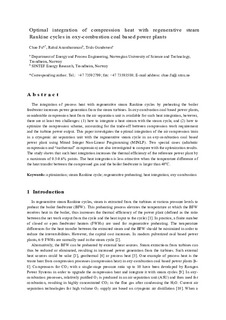| dc.contributor.author | Fu, Chao | |
| dc.contributor.author | Anantharaman, Rahul | |
| dc.contributor.author | Gundersen, Truls | |
| dc.date.accessioned | 2018-03-15T09:25:28Z | |
| dc.date.available | 2018-03-15T09:25:28Z | |
| dc.date.created | 2015-04-09T09:58:31Z | |
| dc.date.issued | 2015 | |
| dc.identifier.citation | Energy. 2015, 84 612-622. | nb_NO |
| dc.identifier.issn | 0360-5442 | |
| dc.identifier.uri | http://hdl.handle.net/11250/2490648 | |
| dc.description.abstract | The integration of process heat with regenerative steam Rankine cycles by preheating the boiler feedwater increases power generation from the steam turbines. In oxy-combustion coal based power plants, considerable compression heat from the air separation unit is available for such heat integration, however, there are at least two challenges: (1) how to integrate a heat stream with the steam cycle, and (2) how to optimize the compression scheme, accounting for the trade-off between compression work requirement and the turbine power output. This paper investigates the optimal integration of the air compression train in a cryogenic air separation unit with the regenerative steam cycle in an oxy-combustion coal based power plant using MINLP (mixed Integer non-linear programming) Two special cases (adiabatic compression and “isothermal” compression) are also investigated to compare with the optimization results. The study shows that such heat integration increases the thermal efficiency of the reference power plant by a maximum of 0.5–0.6% points. The heat integration is less attractive when the temperature difference of the heat transfer between the compressed gas and the boiler feedwater is larger than 40 °C. | nb_NO |
| dc.language.iso | eng | nb_NO |
| dc.publisher | Elsevier | nb_NO |
| dc.rights | Attribution-NonCommercial-NoDerivatives 4.0 Internasjonal | * |
| dc.rights.uri | http://creativecommons.org/licenses/by-nc-nd/4.0/deed.no | * |
| dc.title | Optimal integration of compression heat with regenerative steam Rankine cycles in oxy-combustion coal based power plants | nb_NO |
| dc.type | Journal article | nb_NO |
| dc.type | Peer reviewed | nb_NO |
| dc.description.version | acceptedVersion | nb_NO |
| dc.source.pagenumber | 612-622 | nb_NO |
| dc.source.volume | 84 | nb_NO |
| dc.source.journal | Energy | nb_NO |
| dc.identifier.doi | 10.1016/j.energy.2015.03.023 | |
| dc.identifier.cristin | 1236178 | |
| dc.relation.project | Norges forskningsråd: 193816 | nb_NO |
| dc.description.localcode | © 2015. This is the authors’ accepted and refereed manuscript to the article. This manuscript version is made available under the CC-BY-NC-ND 4.0 license http://creativecommons.org/licenses/by-nc-nd/4.0/ | nb_NO |
| cristin.unitcode | 194,64,25,0 | |
| cristin.unitname | Institutt for energi- og prosessteknikk | |
| cristin.ispublished | true | |
| cristin.fulltext | postprint | |
| cristin.qualitycode | 2 | |

